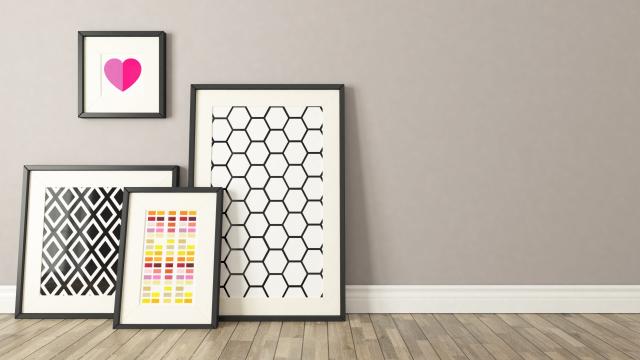Whether it’s paintings from garage sales or you want to display the few family photos you actually printed, there’s a specific art to hanging your art. Fortunately, the basic rules of curation aren’t as tricky as they might seem — with just a creative eye and simple measurements, you can create a great aesthetic on your home’s walls. Here’s some information to consider when creating your own gallery.
Know what kind of wall you have
Older homes built before the 1940s often have plaster walls, which flake and break when punctured. If you have plaster walls, you’ll need to use masonry anchors — plastic cylinders that fit inside a drilled hole in the wall for the screw to fasten into and hold securely — to properly hang your artwork without excessive damage to the wall or loss of hanging strength. Use them to make sure you don’t ruin your walls or come home to fallen paintings and pictures.
Modern homes typically use drywall, though, which is better able to hold your nails and screws, as long as you don’t mind holes when they’re removed. If you don’t want to muck up your walls at all, you can use removable adhesive strips and save yourself the headache of filling holes. Some removable adhesives (like command strips) can hold anywhere from five to 30 pounds of weight without damaging walls.
Measure the proper hanging height
You typically want to hang artwork and photos at eye level — which, according to most museums, means that the centre of the artwork is about 1.5 metres up from the floor. Calculating the centre of the artwork is the straightforward: you just take the height and divide it by two. Whether you’re using command strips or nails and screws, the measurements should stay the same.
[referenced id=”1036005″ url=”https://www.lifehacker.com.au/2020/11/how-to-find-a-stud-without-a-stud-finder/” thumb=”https://www.gizmodo.com.au/wp-content/uploads/sites/4/2020/11/11/mulsb16hjtluuyldoyoc-300×169.jpg” title=”How to Find a Stud Without a Stud Finder” excerpt=”We’ve all been there at some point: anxiously trying to find a wall stud while you’re in the process of hanging a picture, shelf, or TV mount. Most stud finders are inconsistent at best, and I’ve found the more I learn about how houses are built, the easier it is…”]
Make a light pencil mark on the wall, then measure out half the height of the artwork going up from the 1.5 metre mark. With a level, make a small horizontal line at that spot — this is where the top of your piece will be. Measure from the top of the piece to where the hanging holes or wire is (if applicable), and measure down from the horizontal line to where your nail or screw will need to be. If you’re using a removable adhesive tape, you can simply apply the adhesive at that mark on the wall.
Choose a focal point for collages
Before hammering into your walls, plan your photos and their layout. The focal piece will be the largest images, typically in the centre of the collage. When hanging, start from the centrepiece and work your way out. If you are placing artwork above any furniture leave 15-20 centimetres from the bottom of the piece to the couch or furniture. Leaving this amount of space maintains eye level for your piece and removes risks of anyone’s head hitting the artwork when they sit.
Hang artwork equidistant from each other
Hang your pieces next to each other about 8 to 15 centimetres apart. It’s a general practice to leave 30% of the wall exposed in a space, which will also help determine the number of pieces you’re able to hang. Measure the length and width of the walls, along with each piece you have, to help get an idea of how many pieces you can actually fit into the space. There’s no set number of pieces you should hang, but follow those spacing guidelines and you can fit as many pieces your heart desires — or, rather, that the space will allow.

Leave a Reply
You must be logged in to post a comment.